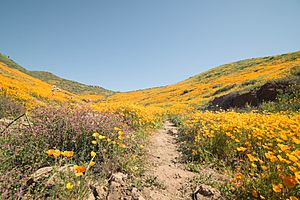Flora of the Sonoran Desert facts for kids
The Sonoran Desert is a special place with many unique plants, known as its flora. It's like a big natural garden! This desert stretches across parts of the United States and Mexico. The plants you find depend a lot on where you are in the desert.
The Sonoran Desert is divided into six main areas based on the types of plants that grow there. Two of these areas are in the United States, and four are in Mexico. For example, the plants in the Colorado Desert are used to very hot and dry conditions. This area often has no trees or large cacti. But in the Arizona Upland, it's a bit lusher with more trees and tall, column-shaped cacti that can handle cold winter nights. South of the border, the plants usually can't handle any frost at all.
Desert Plants
Annuals
The Sonoran Desert has two main rainy seasons: one in winter-spring and another in the summer (called the monsoon season). Many small plants, called annuals, grow from seeds, bloom, and then die all within one year. The annuals that sprout during the winter-spring rains are often similar to plants found in the Mojave Desert.
Cacti
Many different types of cacti live in the Sonoran Desert. These amazing plants are known for storing water and having spines. Here are some of the cacti you can find:
- Barrel Cacti
- Buckhorn Cholla Cacti
- Cardon Cacti
- Englemann Prickly-Pear Cacti
- Fishhook Barrel Cacti
- Ocotillo Cacti
- Organpipe Cacti
- Saguaro
- Senita Cacti
Colorado Desert Plants
The Colorado Desert is a very low area near the Colorado River and its surrounding hills. Plants here have to be super tough to survive the hot and dry weather. Temperatures can go above 49°C (120°F)! Sometimes, less than 8 cm (3 inches) of rain falls in a whole year. As you move from the Arizona Upland into the Colorado Desert, you'll see fewer and fewer plants.
Sometimes, you'll find areas where the wind and water have washed away lighter sand and gravel, leaving behind a layer of pebbles. These pebbles can get stuck together with something called desert varnish, forming a hard surface known as desert pavement. Many plants can't grow through this. Unlike the Arizona Upland where trees are common, they are mostly found only near rivers or where water collects after it rains.
Some common plants here include the burrobush shrub (Ambrosia dumosa), which makes the landscape look grayish, and creosotebush (Larrea tridentata). You'll also see ocotillo (Fouquieria splendens), but they are more spread out. In places where water flows only sometimes, like dry riverbeds, you might find ironwood (Olneya tesota), yellow paloverde (Parkinsonia microphylla), and Smoketree (Psorothamnus spinosus).
The Saguaro cactus (Carnegiea gigantea) still grows here, but not as often as in the Arizona Upland. The Saguaros here are also smaller. You'll hardly see any Saguaros on the California side of the Colorado River.
Desert Holly (Atriplex hymenelytra) is another plant that can handle even the hottest and driest spots in the desert.
Where Deserts Meet
An ecotone is a special area where two different types of plant communities meet and blend together. The ecotone between the hot, dry Colorado Desert and the cooler, wetter Arizona Upland stretches from Parker, Arizona down to near Phoenix, and then south to Organ Pipe Cactus National Monument. As you move from the Arizona Upland into the Colorado Desert, the plants become less dense and more spread out.
Lichens
Dimelaena thysanota is a type of lichen that looks like a crust and grows on rocks.
Trees
Two types of paloverde trees, the blue paloverde (Parkinsonia florida) and the yellow paloverde (Parkinsonia microphylla), are part of the pea family (Fabaceae). Blue paloverde trees have smooth, blue-green bark that helps them make their own food through photosynthesis. You can also find large groups of velvet mesquite (Prosopis velutina) trees in the valleys of the Arizona Upland, especially where colder air tends to gather.


